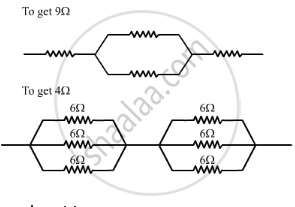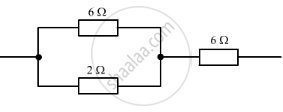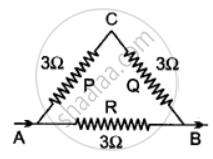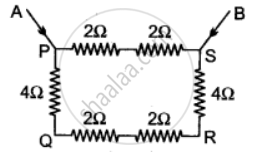Advertisements
Advertisements
Question
Show with the help of diagrams, how you would connect three resistors each of resistance 6 Ω, so that the combination has resistance of (i) 9 Ω (ii) 4 Ω.
Solution
To obtain 9 Ω and 4 Ω , we should connect the resistors as follows:

APPEARS IN
RELATED QUESTIONS
Which of the following arrangement, A or B, has the lower combined resistance?

A wire that has resistance R is cut into two equal pieces. The two parts are joined in parallel. What is the resistance of the combination?
The figure given below shows three resistors?

Their combined resistance is:
(a) `1 5/7`Ω
(b) `14` Ω
(c) `6 2/3` Ω
(d) `7 1/2` Ω
A resistor of 8 ohms is connected in parallel with another resistor X. The resultant resistance of the combination is 4.8 ohms. What is the value of the resistor X?
Four resistors each of resistance 2Ω are connected in parallel. What is the effective resistance?
A particular resistance wire has a resistance of 3 ohm per meter. Find :
The total resistance of three lengths of this wire each 1.5 m long, in parallel.
How does the resistance of a metallic wire depend on the thickness of wire?
Calculate equivalent resistance in the following cases:


Three resistors of 6Ω, 4Ω and 4Ω are connected together so that the total resistance is 8Ω. Draw a diagram to show this arrangement and give reason to justify your answer.
Two V-I graphs A and B for series and parallel combinations of two resistors are as shown. Giving reason state which graph shows (a) series, (b) parallel combination of the resistors.

